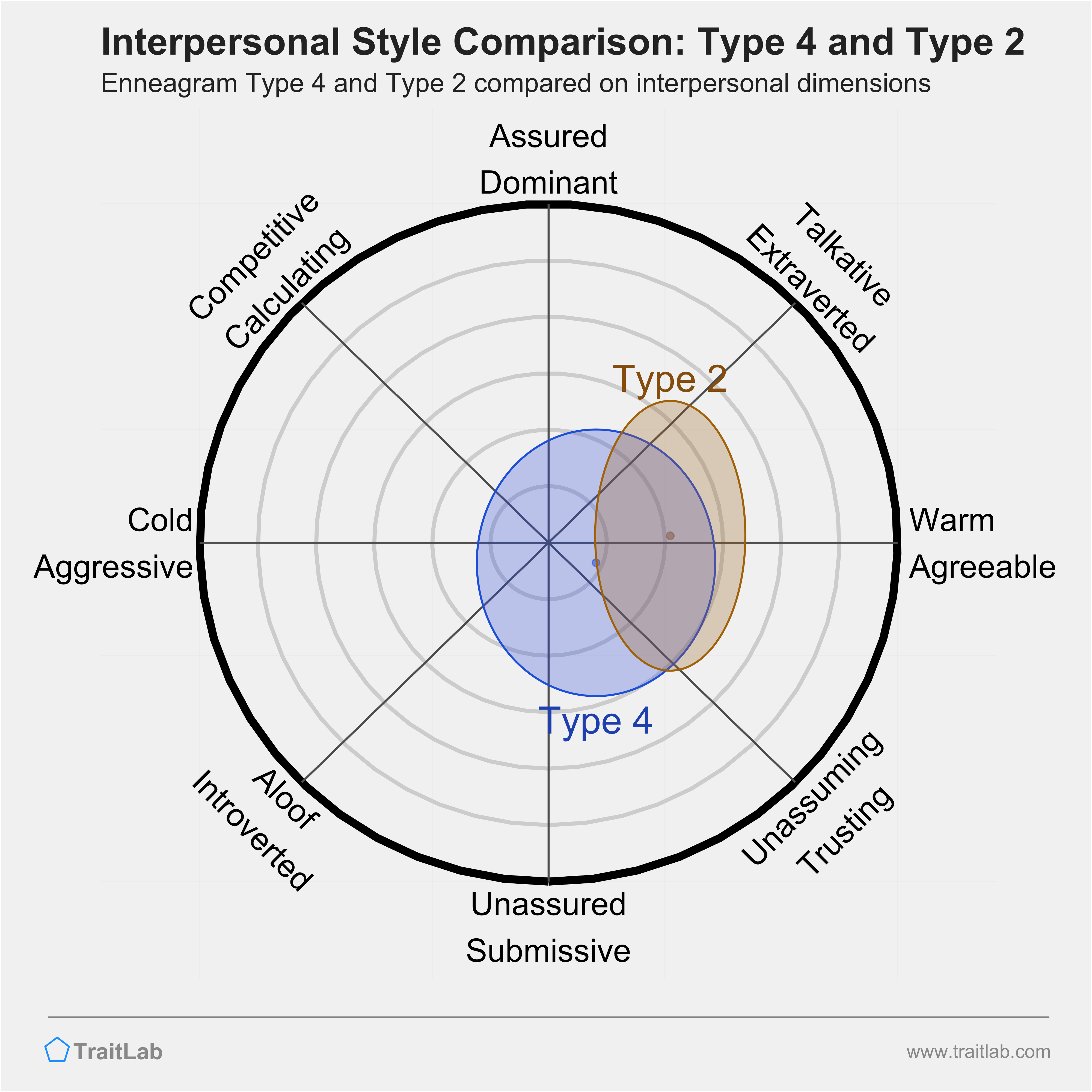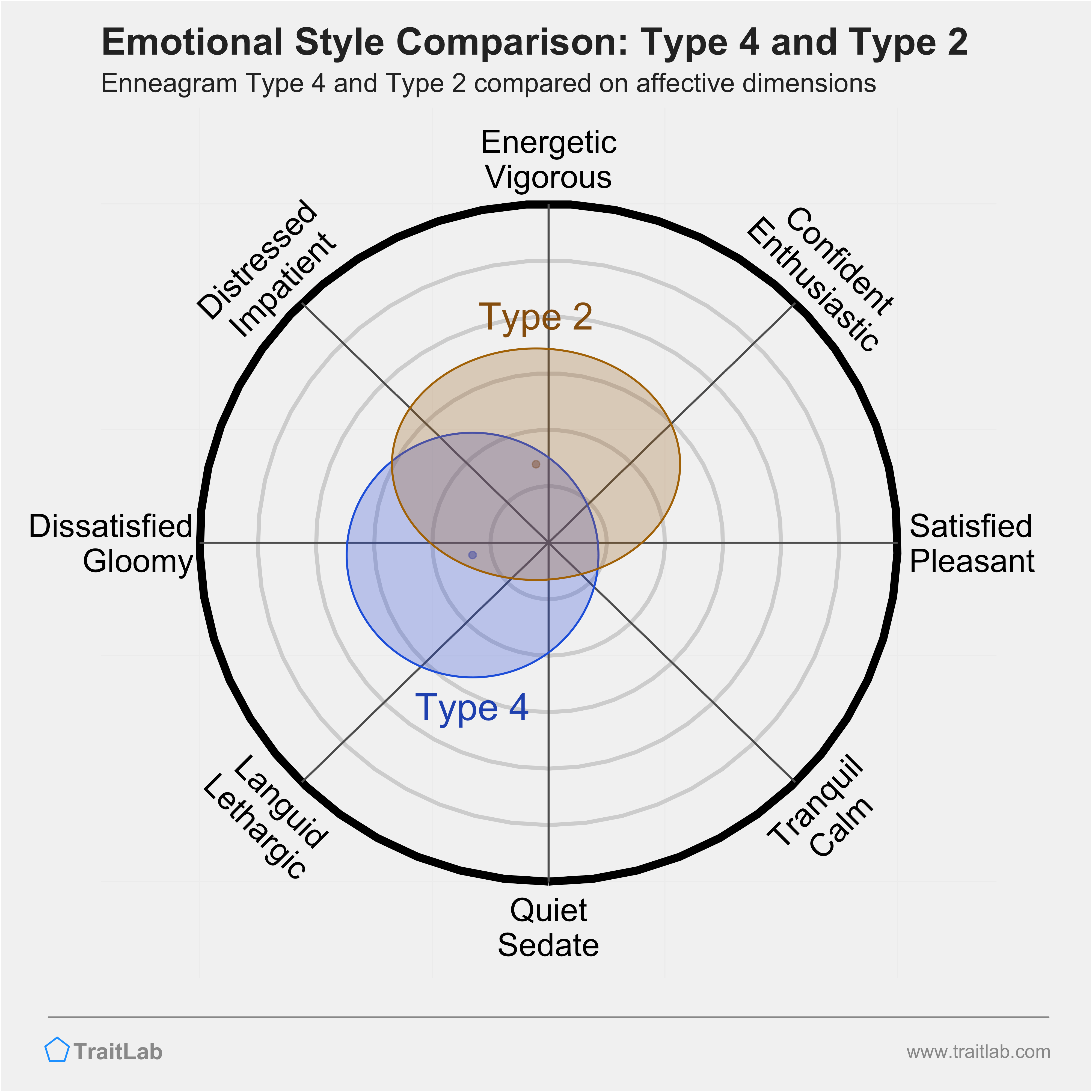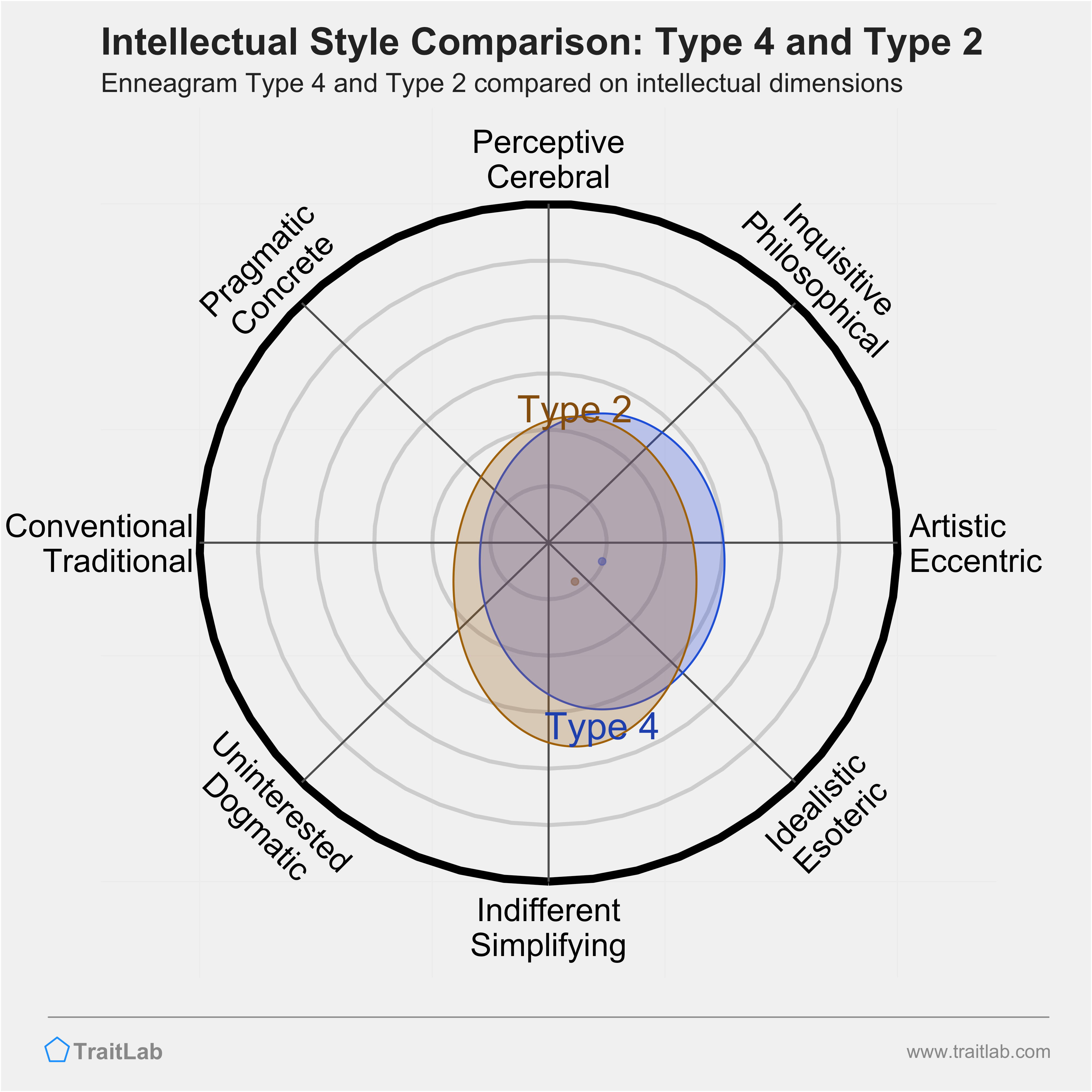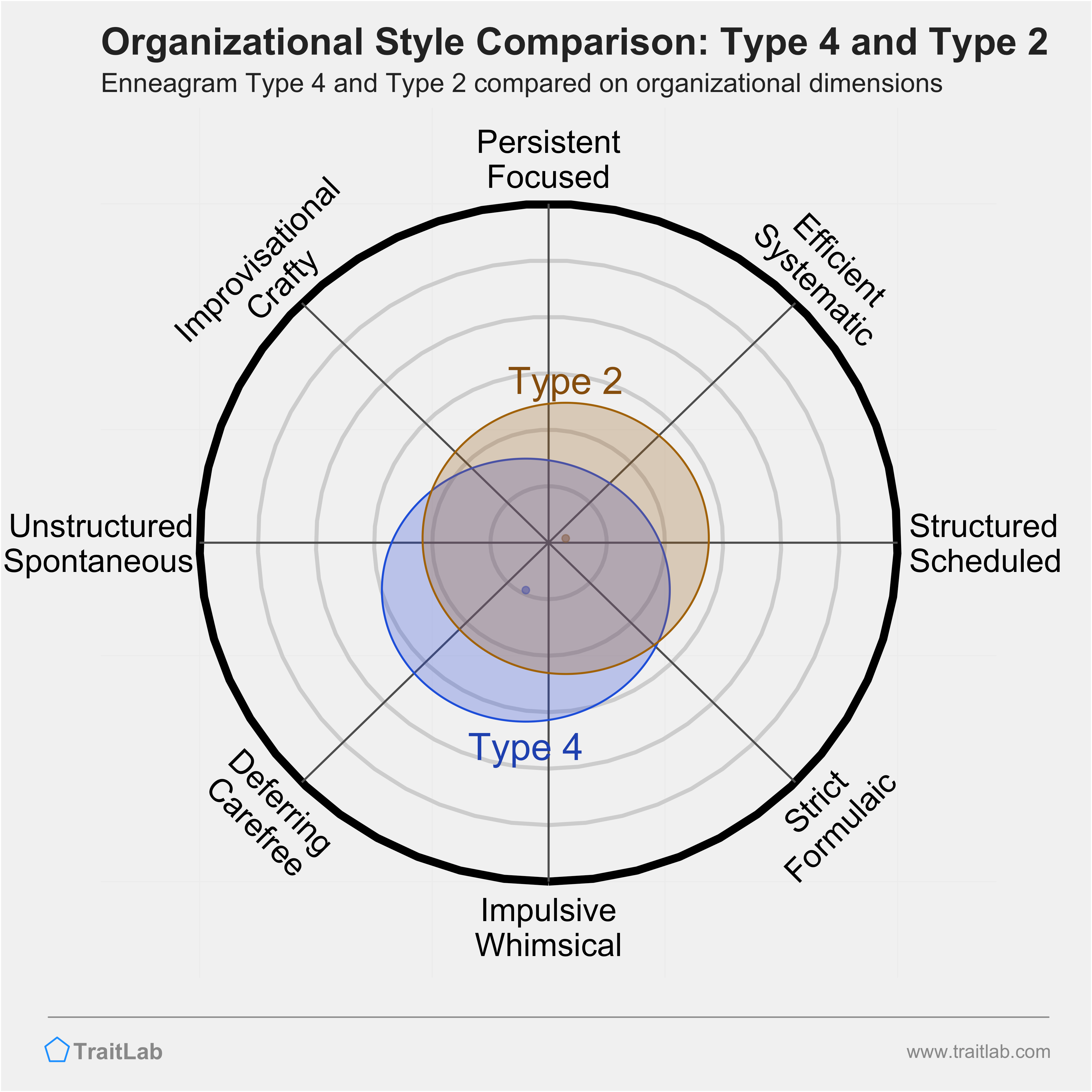How compatible are the Enneagram Type 4 and Type 2 patterns of communicating, feeling, and thinking?
Reading time: 5 minutes

Gregory Park, Ph.D.
Author
In this article, you’ll find comparisons of two Enneagram types — Type 4s and Type 2s — across four important personality domains: Interpersonal/Communication Style, Emotional Style, Intellectual Style, and Organizational Style.
TraitLab collected data about personality traits from thousands of participants who identified as a single Enneagram type.
For each comparison area below, you’ll see show the average similarities and differences between Type 4s and Type 2s. While these comparisons are useful for understanding broad trends across these types, it’s important to remember that all personality types are oversimplifications. For an assessment of your unique personality, you’ll want to use an assessment that goes beyond single personality types.
To learn more about how this typology relates to personality traits, you’ll want to read Enneagram and Big Five Personality Traits.
Jump to any section with the links below.

Do you know your Enneagram type?
Learn about your type and so much more with TraitLab's comprehensive personality assessment.
Your particular style of communicating and interacting with others can be described fairly well by two dimensions: assertiveness and warmth.
Assertiveness describes your tendency to assert yourself, lead, and influence others in social situations, while warmth describes your tendencies to empathize and put others’ needs ahead of your own.
People with the same personality type often share some similarities in assertiveness and warmth. In the graph below, you can see where most Type 4s and most Type 2s fall along both of these dimensions.
First, take a look at where people in each type, on average, fall in this interpersonal space.

Type 4s often respect others, conform to expectations, and ask for guidance. At their best, they are loyal and reliable, and encourage others to guide and help. Type 4s may be overly clingy, gullible, and have difficulty expressing anger, even when appropriate. At their worst, they will try to please others too much, put others’ needs ahead of their own, and allow others to take advantage of them.
Type 2s often agree, trust, and cooperate with others. At their best, they are friendly, affectionate, and bring out the warmth and sympathy in others. Type 2s may be too agreeable and quick to compromise. At their worst, they may seek approval and agreement too much, and be dependent on the approval of other people.
One aspect that you and many Type 2s have in common in their interpersonal warmth. Both Type 4s and Type 2s tend to be on the friendlier side and are attentive to the needs and interests of other people, sometimes at the expense of your own goals.
One important difference between you and most Type 2s is in your relative assertiveness or passivity in social situations. Like many Type 4s, you are often on the more passive, reserved side of the spectrum. In some cases, this is a perfect compliment to Type 2s’ more dominant, assertive style, and the two of you can make an effective team. However, you may find that you need to put extra effort into making your opinions heard when working with Type 2s.
Another characteristic of your personality is your emotional style — your tendencies towards different kinds of moods. There are two dimensions that influence emotional style: arousal and valence.
Arousal describes your relative energy level across different situations. Those with high baseline levels of arousal tend to be generally more alert, active, and engaged, while those with a lower baseline are more reserved, subdued, and inhibited.
Valence describes whether these moods tend to be positive (pleasant) or negative (unpleasant). People with a more positively valenced style are more likely to experience emotions like joy, enthusiasm, satisfaction, and serenity. People with a more negatively valenced style are more likely to experience sadness, frustration, dissatisfaction, and anxiety.
The graph below shows where each type, on average, usually sits in this emotional space.

Type 4s have a tendency to be quiet and inhibited. Compared to most people, they can easily drift into gloom and melancholy. They see the glass as half-empty and have a more skeptical outlook and a hesitant approach to life. For better or worse, Type 4s tend to notice the negatives in most situations. In stressful times, they are more likely to withdraw quietly and retreat inward, rather than share their frustration with others.
Type 2s tend to be tense, concerned, and vigilant in many situations. They usually have a pessimistic outlook and are often looking for what could go wrong next. Type 2s are highly active and tend to juggle many tasks. When things go wrong, this energy can turn into frustration and impatience, and they are more likely to express their dissatisfaction to others.
As with most Type 4s, you tend to be more reserved, inhibited, and quiet than most Type 2s. Between the two of you, you are more likely to need more personal space, solitude, and time to decompress. While you can tolerate long periods of calm and quiet, your Type 2 counterparts often craves more engagement and excitement. In the best cases, a Type 2 can pull you out of your comfort zone and get you out into the world, while your quiet nature helps to balance out their intensity.
However, Type 4s and Type 2s often default to the negative side of the emotional spectrum. While you may not always express them, you are both more likely to experience negative emotions like sadness, worry, frustration, and impatience. It’s rare to find Type 4s or Type 2s in a bubbly, cheerful mood. Like most people, they have moments of joy and satisfaction, but these dissipate quickly. They often point out the negatives in most situations and have a more pessimistic outlook.
Your intellectual style describes how you receive, process, and pursue different kinds of information. Differences in intellectual style are captured well by two dimensions: ideas and aesthetics.
Ideas describes your appetite for new information and your interest in complex, challenging material. People high on the ideas dimension have an appreciation for complexity and technical details. People lower on ideas are less interested in learning for learning’s sake, and they prefer to simplify complex topics down to the essential details.
Aesthetics captures your relative interest and sensitivity to aesthetic information and its emotional impact. People higher on the aesthetics dimension usually have strong artistic interests and a deep appreciation for beauty in many forms. Those lower on aesthetics tend to value practical application over artistic merit and usually adhere to more conventional standards of beauty.
In the graph below, you’ll see where Type 4s and Type 2s, on average, fall in this intellectual space.

Most Type 4s and Type 2s overlap heavily in their intellectual style.
Type 4s and Type 2s are idealistic, creative dreamers. They tend to be interested in the nuances of emotional and artistic experiences, looking for patterns and meaningful insights. Type 4s and Type 2s are comfortable with ambiguity and abstract concepts, focusing on the big picture rather than technical details. They often practice some form of creative expression and are likely to hold a few unconventional, eccentric beliefs.
As a Type 4, you and most Type 2s are down-to-earth, straightforward thinkers. You’d both prefer to stick to the essentials and focus on practical issues, and you try to avoid overcomplicating matters. When you and your Type 2 counterpart are together, your conversations are more likely to revolve around concrete details, facts, and conventional topics rather than theoretical or philosophical ones.
Likewise, both Type 4s and Type 2s share a deep appreciation for beauty in the natural and artistic world. Both of you can easily become absorbed in aesthetic experiences and overcome with a sense of awe and wonder. The two of you can find common ground in your love of creative expression and unconventional approaches to life’s challenges.
Your organizational style describes your habits around organization and planning. Your organizational style influences how you structure your time and physical space. Differences in organizational style fall along two dimensions: industriousness and orderliness.
Industriousness describes your persistence, need for achievement, and intensity of focus. People higher on industriousness usually organize their behavior around a few important long-term goals. People lower on industriousness are usually more focused on the present and will more easily change their focus when new opportunities appear.
Orderliness describes your need for regularity, order, and structure in your environment. People higher on orderliness prefer tidy, organized physical spaces, detailed schedules, and reliable routines. People lower on orderliness can tolerate more disorganization and prefer a more spontaneous, unstructured approach.
The graph below shows the average position of Type 4s and Type 2s along these dimensions of organizational style.

Type 4s thrive in unstructured environments with fewer constraints and more room for improvisation and serendipity. They generally focus on enjoying the present rather than preparing for the future. Type 4s highly value spontaneity and the flexibility to change their mind, and they resist setting hard deadlines or rigid expectations.
Type 2s are usually systematic and highly organized. They like setting big, long-term goals and then creating detailed plans to accomplish them. Type 2s are generally good at ignoring distractions and making steady progress through consistent routines and habits.
Like many Type 4s, you and most Type 2 often differ in your need to achieve explicit goals and use your time productively. While you embrace the here and now, your Type 2 counterpart is often thinking about and planning for the future. When you are keeping your eyes out for new, interesting opportunities, Type 2s are usually working away with their heads down. This difference between your present-oriented mindset and their future-oriented one can create occasional tension. However, this difference also helps you balance the other out at times. Your Type 2 counterpart often needs you to break them out of their need for productivity and efficiency while they can provide you with additional focus and motivation.
A second difference between Type 4s and Type 2s is in their relative need for routine, structure, and order. You and most Type 4s are more comfortable with an unplanned, spontaneous approach to life, while your Type 2 counterpart often wants plans, schedules, and well-defined procedures. Type 2s thrive on routine and predictability, whereas Type 4s find the same level of organization to be overbearing and constraining. These differences in tidiness, punctuality, and comfortability with deviating from social expectations can be a consistent source of conflict between the two of you.
Most people have complex personalities and can’t be described perfectly by a single Enneagram type.
With TraitLab’s comprehensive analyses of your traits, strengths, and interests, you can see how your personality compares to all nine Enneagram types. Start building your personality profile by creating a free account today.
For comparisons between Type 4s and other Enneagram types, visit any of the type pairings below:
For comparisons between Type 4s and other types from the 16 Personality typology, visit any of the pairings below: